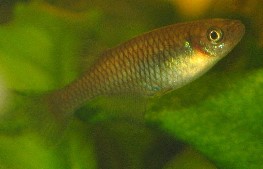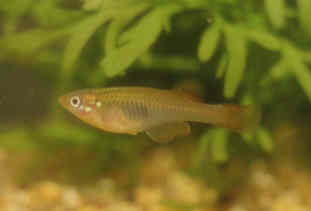| Meaning
of Name |
Modest. |
| First
Description |
(Pappenheim
P. 1914) Pappenheim P. & G.A. Boulenger
1914. Fische. Wissenschaftliche ergebnisse der deutschen Zentral-Afrika Expedition
1907-1908.
Zoologie 5 (2): p 252 - 253. |
| Size |
Males 50 mm, females 40 mm after Radda & Pürzl
1987. Some reports have suggested sizes up to 54 mm SL in Pellegrin 1928 &
56 mm SL in Poll 1939. |
| Meristics |
- D = 9 -11, A = 17-18, ll = 31 (Pappenheim 1914)
- D
= 11-12, A = 19-21, ll = 30-33 Pellegrin 1928
- D
= 12-13, A = 19-21, ll = 31-32 Worthington 1932
- D
= 12-13, A = 19-21, ll = 30-33 Poll 1939
- D
= 12-13, A = 20-21, ll = 31-32, D/A = 1/8-9 Poll & Lambert 1965
- D
= 12-13, A = 19-21, ll = 30-33 Greenwood 1966
- D
= 12-13, A = 20-22, ll = 31-32 (+2-3) Radda & Pürzl 1987
|
| Karyotype |
|
| Sub-Genus |
|
| Group |
|
| Synonyms |
- Haplochilus modestus
Pappenheim 1914
- Haplochilichthys modestus
Ahl 1924
- Platypanchax modestus
Ahl 1928
- Hypsopanchax modestus
Lazara 1983
- Haplochilus
(Hypsopanchax) Deprimozi
Pellegrin 1928
- Hypsopanchax deprimozi
Myers 1933
- Aplocheilichthys
(Hypsopanchax) deprimozi
Poll 1939
- Haplochilichthys analis
Worthington 1932
- Aplocheilichthys analis
Myers 1933
- Hypsopanchax analis
Huber, Seegers & Wildekamp 1983
|
Populations
- Fort Portal (western Uganda)
- Rutshuru
- Rwimi
River
|
|

Photo courtesy
of Mögens Juhl
|

Female
Photo courtesy of Mögens Juhl
|

One of my old
shots of the sp. taken in the UK.
|
|
| Type
Locality |
Reported
as a forest stream near old Beni in the Ituri River drainage, northeastern Democratic
Republic of Congo. Reference 29° 28' E; 00° 29' N. |
| Distribution |
Found on the slopes of the Western Rift Valley
draining into Lake Edward & Lake George. Also in the Semliki River
above the falls & in the upper Ituri River drainage, northeast DRC
& western Uganda.
Area extends almost to that of Aphyosemion
christyi but this area seems to be populated by an intermediary
species between modestus & Hypsopanchax
platysternus.
|
| Habitat |
Inhabits fast flowing streams coming from the Ruwenzori
Mountains. |
| Distinguishing
Characteristics |
Rusty
red colouration in caudal & dorsal fins & rear part of the body.
Neon green stripe on top of body from the rear of the head to the dorsal
fin. |
| Colour/Pattern
Variability |
Unknown
but probably low. |
| History |
|
| Breeding
Notes |
Brian
Perkins of the AKA New & Rare Sp. sent me some helpful notes on breeding this
sp.- 1) Lots of cool (20-24°C) clean
water stimulates spawning. A 40l tank houses 10 pairs nicely. The more water changes
you do, the more eggs you will get!
2) Eggs are very large and are easy
to handle, fertility has been very high- near 100%
3) Most, if not all,
eggs will be found in a bottom mop. Floating mops are all but ignored except where
the strands reach the bottom of the tank. Water incubate them (supplemental aeration
of the hatching tray is not necessary for this spp. Of Lampeye.) @ 22°C and
expect hatching in about 10 days. Fry are large at hatching and will take BBS
from the beginning.
4) Expect a steady, not spectacular, stream of
eggs from them.
5) Males are not hard on females they school very nicely.
6)
For optimal growth of the babies, segregate fry by size, as the largest fry suppress
the growth of the smallest.
7) Keep the water moving so that they have
a current to swim against.
8) They are easy to feed and will take all
foods. Bursts of egg production seem to come after heavy feeding of tubificid
worms. I have never seen them reject any food offered including frozen and flake
food.
9) They are not shy and will come
to the front of the tank to be fed, very high potential for community tank keeping
as they get along with all manner of fish of similar size and temperament.
10)
For best color, position their tank so that you stand with your back to the light
source and the light is coming in over your shoulder, natural light is best....
11)
They are long-lived, and very hardy. Thanks
Brian. |
| Diameter
of Egg |
Described
as 'relatively large' in Wildekamp's ''A World of Killies'. |
| Remarks |
Common names associated with this sp. include Ruwenzori
Lampeye & Semliki Lampeye. |



